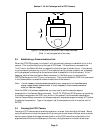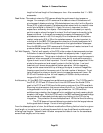Section 4 - Camera Hardware
Page 23
4. Camera Hardware
This section describes the modular components that make up the CCD Camera System and
how they fit into the observatory, with all their connections to power and other equipment.
4.1. System Components
The ST-7E, ST-8E and ST-9E CCD cameras consist of four major components: the CCD Sensors
and Preamplifier, the Readout/Clocking Electronics, the Microcontroller, and the power
supply. All the electronics are packaged in the optical head in these cameras with an external
desktop power supply.
The CCDs, Preamplifier, and Readout Electronics are mounted in the front of the optical
head. The optical head interfaces to the telescope through a 1.25 inch draw tube, sliding into
the telescope's focus mechanism. The placement of the preamplifier and readout electronics
close to the CCD is necessary to achieve good noise performance. The Microcontroller is
housed in the rear of the Optical Head along with the interface logic to the PC and Telescope.
4.2. Connecting the Power
The desktop power supply is designed to run off wall voltage, and both domestic (110 VAC)
and European (220 VAC) versions are available. In the field however, battery operation may be
the most logical choice. In that case you need to use the optional 12V power supply or a
12VDC to 110 VAC power inverter.
4.3. Connecting to the Computer
The ST-7E, ST-8E and ST-9E CCD Cameras are supplied with a 15 foot cable to connect the
system to the host computer. The connection is between the camera and the Host Computer's
parallel LPT port. The camera will operate properly with up to 50 feet of cable to the computer.
The computer's parallel port is easily identified since it is a 25 pin Female D connector.
4.4. Connecting the Relay Port to the Telescope
The ST-7E, ST-8E, and ST-9E camera systems can be used as autoguiders where the telescope's
position is periodically corrected for minor variations in the RA and DEC drives. The host
software functions as an autoguider in three modes: the Track mode, the Track and
Accumulate mode (SBIG patented), and Self Guided mode (SBIG patented).
In the Track mode and Self Guided mode the host software corrects the telescope as
often as once every 2 seconds to compensate for drift in the mount and drive system. The host
software and the CCD camera operate in tandem to repeatedly take exposures of the
designated guide star, calculate its position to a tenth of a pixel accuracy, and then
automatically activate the telescope's controller to move the star right back to its intended
position. It does this tirelessly to guide long duration astrophotographs.
In the Track and Accumulate mode the software takes a series of images and
automatically co-registers and co-adds the images to remove the effects of telescope drift.
Typically you would take ten 1 minute "snapshots" to produce an image that is comparable to a
single 10 minute exposure except that no guiding is required. The reason no guiding is


















